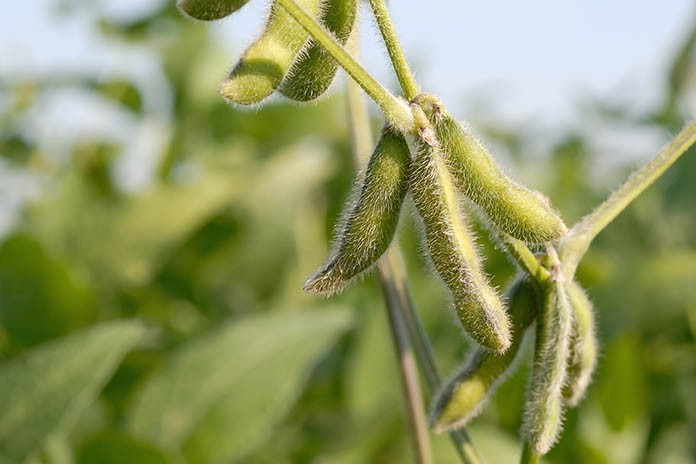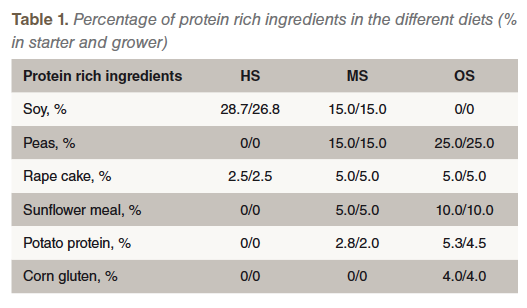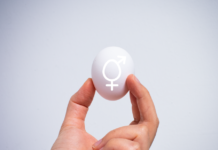
The objective of the present study was to evaluate the effect of replacing soybean meal (SBM) in broiler diets on performance, carcass quality and production cost.
A randomized trial (36 d) was conducted using 20 pens (20 m2, 280 Ross PM3 birds). A starter and grower diet (12.6/13.0 MJ ME, 210/200 g CP, 12.8/12.2 g lysine) were fed as crumbs. The diets contained either a high level of SBM (HS; starter/grower: 28.7/26.8% SBM and 2.5/2.5% rape seed meal (RSM)), a medium level of SBM (MS; starter/finisher: 15.0/15.0% SBM, 15.0/15.0% peas, 5.0/5.0% RSM, 5.0/5.0% sun flower meal (SFM), 2.8/2.0% potato protein (PP) or no SBM (NS; starter/grower: 25.0/25.0% peas, 5.0/5.0% RSM, 10.0/10.0% SFM, 5.3/4.5% PP, 4.0/4.0% corn gluten).
Treatments were HS/HS, MS/MS, MS/NS, NS/NS for starter/finisher diets. Performance parameters, litter quality, hock burns (HB) and foot pad lesions (FPL) were recorded and analysed by using ANOVA and Tukey-Kramer.
Feed intake for HS/HS, MS/MS, MS/NS, NS/NS was 3438a g, 3481ab g, 3574b g, 3580b g (P, 0.003). Body weight (Ø 2234 g), FCR (Ø 1.57) and mortality (Ø 2.14%) did not differ between treatments. The ratio of water/feed intake was highest in HS/HS. This led to lower litter quality and significantly higher scores for FPL compared to the other treatments. Carcass yield (Ø 69.50%) and composition did not differ between treatments. Feed ingredient costs were 5% higher for NS/NS compared to HS/HS. Overall performance was comparable between treatments, however, SBM led to a significantly higher occurrence of FPL.
Markets and politics demand a more sustainable food production system. In the sustainability discussion soy production and trade is often a controversial issue. Even though 80 – 90 % of soy imported into Switzerland fulfils high standards concerning the sustainability of production, the acceptance for soy imports is missing by part of the consumers. Furthermore, the price for GMO-free soy has risen over the last years.
Material and methods
The trial involved four dietary treatments and 5600 as hatched Ross PM3 birds. The birds (280 per pen) were randomly assigned to 20 pens of 20 m2 each. The trial lasted 36 days. Barn climate was based on the commercial standards for the breed. A starter diet (12.6 MJ ME, 210 g CP, 12.8 g Lysin, 9.0 g Ca und 6.5 g P) and a grower diet (13.0 MJ ME, 200 g CP, 12.2 g w, 7.5 g Ca und 5.5 g P) were fed as crumbs ad libitum. The diets contained either a high level of SBM (HS), a medium level of SBM (MS) or no SBM (NS) (Table 1). Treatments were HS/HS, MS/MS, MS/NS, NS/NS for starter/grower diets.
 Feed structure and composition were analyzed. Standard performance parameters, water intake, litter quality (% crusted surface), footpad lesions and hock burns were recorded (0 = no change; 3 = strong change). In addition, carcass grading and composition were evaluated. Data were analyzed by ANOVA and means compared with the test of Tukey-Kramer.
Feed structure and composition were analyzed. Standard performance parameters, water intake, litter quality (% crusted surface), footpad lesions and hock burns were recorded (0 = no change; 3 = strong change). In addition, carcass grading and composition were evaluated. Data were analyzed by ANOVA and means compared with the test of Tukey-Kramer.
Results
Feed composition was in agreement with calculated values and feed structure was comparable between treatments (data not shown). Treatments with no SBM in the grower diet led to a significant higher feed intake compared to HS/HS. Body weight, FCR and mortality were not affected by treatments. EBI was between 363.4 and 377.2 (Table 2).
 The ratio of water/feed intake was highest in HS/HS (Table 3). This led to lower litter quality (92% of surface crusted in HS/HS pens) and significantly higher scores for FPL compared to the other treatments. HS/HS also showed the highest average score for HB (Table 3).
The ratio of water/feed intake was highest in HS/HS (Table 3). This led to lower litter quality (92% of surface crusted in HS/HS pens) and significantly higher scores for FPL compared to the other treatments. HS/HS also showed the highest average score for HB (Table 3).
 All treatments achieved excellent carcass quality with over 97.5% grade 1. Average carcass yield was 69.50% and was not affected by treatment. Dietary protein source did not influence carcass composition (Table 4).
All treatments achieved excellent carcass quality with over 97.5% grade 1. Average carcass yield was 69.50% and was not affected by treatment. Dietary protein source did not influence carcass composition (Table 4).
 Conclusions
Conclusions
Diets with no SBM led to a significantly higher feed intake compared to diets with SBM. However, weight gain and FCR were not affected by diet composition. Overall performance of SBM-free diets was comparable to the standard commercial diet with SBM. Dietary composition did also not influence carcass composition. Carcass composition has been shown to change with suboptimal protein nutrition. The lack of difference indicates that all birds received adequate and comparable protein and amino acid supply.
SBM-free diets led to significantly lower water to feed intake. This could partially be explained by the lower potassium concentration in diets without SBM. The lower water intake led to healthier skin on the legs. Both foot pad lesions and hock burns were lower in diets with no SBM. This is in agreement with Tucker and Walker (1999) who also reported a link between litter quality and the occurrence of FPL and HB.
SBM could be replaced with little change in performance and a significant reduction in FPL and hock burns. However, feed ingredient cost were 5% higher for diets without SBM compared to diets with high inclusion of SBM. In the market, not all alternative protein sources used in the trial (particularly potato protein) are available in sufficient amounts to switch a larger market segment to diets without SBM. Therefore, SBM-free diets could only play a role in niche markets where the extra cost can be passed on to the customer.
References are available on request.
Presented at the European Symposium on Poultry Nutrition

















